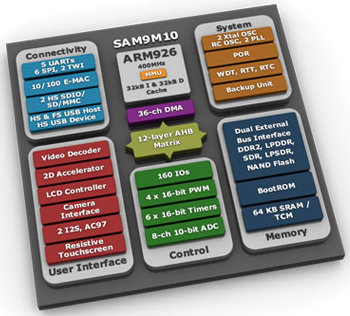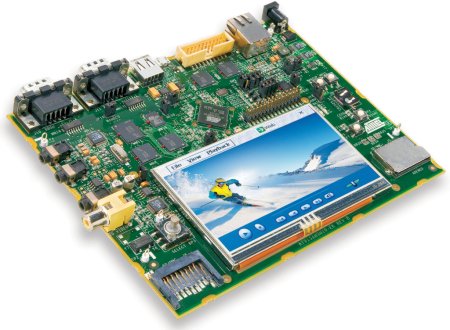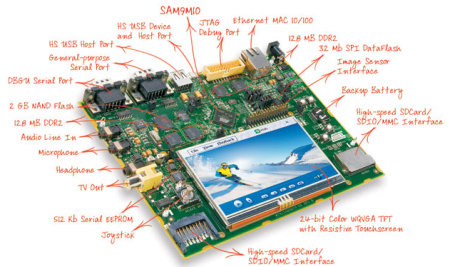ARM9 industrial SoC gains video chops
Jan 11, 2010 — by Eric Brown — from the LinuxDevices Archive — 3 viewsAtmel announced a version of its ARM926EJ-based “SAM9” line of industrial-focused system-on-chips, this time integrating a video decoder and graphics acceleration. The SAM9M10 ships with a Linux evaluation board and BSP, and supports video at up to 720 x 576 pixels and 30 frames per second, says the company.
The SAM9M10 is targeted at multimedia display and control panels in applications such as home/office monitoring, Point of Sale (PoS) terminals, entertainment systems, Internet appliances, and medical devices, says Atmel.
The SAM9M10 is pin-compatible with the SAM9G45 system-on-chip (SoC) announced last July, says the company. Like the SAM9G45, the SAM9M10 is built around a 400MHz ARM926EJ core that integrates twin parallel external bus interfaces (EBI) to support DDR2 memory at 133MHz. The SoC similarly integrates high-speed (480Mbps) USB host and device ports with on-chip transceivers, says Atmel. The USB host is fully compliant to the EHCI and OHCI standards, enabling "straightforward porting of proven USB host drivers," says the company.

SAM9M10 architecture
When it comes to video, however, the SAM9M10 steps out from the shadow of its predecessor. With its new video decoder, the SoC can decode video streams at up to D1 (720 x 576), or WVGA (800 x 480) at 30 frames per second (fps), claims Atmel. The decoder is also said to support H264, H263, MPEG4, MPEG2, VC1, and JPEG formats. New 2D graphics acceleration, meanwhile, offers image scaling and image rotation, color space conversion (YUV to RGB), and picture-in-picture capability, says the company.
The SAM9M10's 12-layer system bus matrix is said to be linked to the Memory Management Unit (MMU) of the processor core, as well as to eight central DMA channels, six high-speed DMAs, each dedicated to the video decoder, 21 Peripheral DMA (PDC) channels, dual EBI, small blocks of on-chip distributed SRAM, and the aforementioned LCD, USB, Ethernet, and imaging peripherals, says Atmel. As a result of this "high data speedway" architecture, the SAM9M10 can perform 100Mbps+ data transfers, video decoding, and UI rendering in parallel with computationally intensive data processing, claims the company.
Running at 400MHz with a 1.0V core supply, power consumption is typically less than 300uW/MHz, claims Atmel, and in backup mode with the RTC running, the SAM9M10 is said to consume about 8 uA. The system controller incorporates startup, shutdown, and power-on reset controllers, as well as on-chip oscillators for 12 MHz and 32 KHz, and a power management controller (PMC).
SAM9M10-EK evaluation kit
As with earlier SAM9 SoCs, the SAM9M10 is offered with an hardware/software evaluation kit and supported by a Linux or Windows CE BSP (board support package). The kit includes an Atmel SAM9M10-EK board that appears to be identical to the earlier SAM9G45-EK board except for the inclusion of the different SoC model.
The board offers two banks of 128MB DDR2 memory, each connected to an external bus interface, as well as 2GB of NAND, and 32MB (2M x 16) of flash memory dedicated to storing application data or firmware uploaded into DDR2 memory at system boot. Dual high-speed SD/SDIO/MMC slots are also said to be supplied.

SAM9M10-EK evaluation board
(Click to enlarge)

SAM9M10-EK (detail)
(Click to enlarge)
Availability
The SAM9M10 is sampling now, and priced at $11.40 in quantities of 10k units, under the order code AT91SAM9M10-CU, say Atmel. The SAM9M10 evaluation kit is available now at $750 for single-unit quantities (order code AT91SAM9M10-EKES). More information may be found here, More information on the Linux BSP for the SAM9M10 may be found here.
This article was originally published on LinuxDevices.com and has been donated to the open source community by QuinStreet Inc. Please visit LinuxToday.com for up-to-date news and articles about Linux and open source.